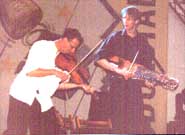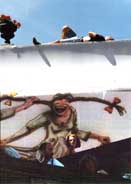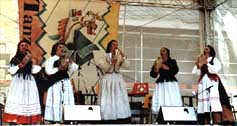 On the German side of things, the Leipziger Folksession Band gave an impressive concert at the castle yard. It is a big band combining the creme of the Leipzig folk music talent - both young and old. Their repertoire bases on German "Revolluzzer" (revolution) songs, their singers include the rough voices of Jens-Paul Wollenberg, Jürgen B. Wolf and Manfred Wagenbrethm and the band includes the likes of ULMAN (the best German folk youngsters of the Uhlmann family on tuba/flute/recorder, hurdy gurdy/fiddle and melodeon) and members of the Leipzig bands Wmmerschinken and Bierfiedler. It's loud stuff, but lots of fun and appeal.
On the German side of things, the Leipziger Folksession Band gave an impressive concert at the castle yard. It is a big band combining the creme of the Leipzig folk music talent - both young and old. Their repertoire bases on German "Revolluzzer" (revolution) songs, their singers include the rough voices of Jens-Paul Wollenberg, Jürgen B. Wolf and Manfred Wagenbrethm and the band includes the likes of ULMAN (the best German folk youngsters of the Uhlmann family on tuba/flute/recorder, hurdy gurdy/fiddle and melodeon) and members of the Leipzig bands Wmmerschinken and Bierfiedler. It's loud stuff, but lots of fun and appeal.
Then there were Natalie MacMaster Band, Fiedel Michel (the German legend), La Cucina, De Dannann, ...
One of the main features of this year's festival was the European showcase. As Rudolstadt's neighbouring town, Weimar, is this year the cultural capital of Europe, Rudolstadt decided to dedicate their usual country focus concert this year to all nine cultural capitals of Europe in the year 2000, with bands from each town playing. Actually the idea for this concert was great - but the way it was presented was quite strange. The announcements should be made by a renowned theatre acteur who was not able to come that day. But they did find another theatre acteur to replace him. Well but why did they need an acteur to read some parts of the programme brochure to the audience?
 During the breaks between each act, the German "Bayon" played some music - unfortunately without any relation to the acts playing before and afterwards. Additionally, the representants of the nine countries were all totally different and only some of them represented the typical styles of the towns and countries, ranging from traditional Spanish cantigas and trad folk rock from Prague over world music from Brussels to really strange modern avantgarde music from Helsinki. This made the whole concert become a strange mixture of different styles, and there was no obvious continuity in this European journey. I thught this concert would become one of the highlights of the festival, but I did not enjoy it very much.
During the breaks between each act, the German "Bayon" played some music - unfortunately without any relation to the acts playing before and afterwards. Additionally, the representants of the nine countries were all totally different and only some of them represented the typical styles of the towns and countries, ranging from traditional Spanish cantigas and trad folk rock from Prague over world music from Brussels to really strange modern avantgarde music from Helsinki. This made the whole concert become a strange mixture of different styles, and there was no obvious continuity in this European journey. I thught this concert would become one of the highlights of the festival, but I did not enjoy it very much.
An important place in the programme has also the "ceilidh" dance, with dances from all around Europe to join in. One stage is exclusively dedicated to dancing, and you can dance till you drop with a big number of live bands from Germany and Europe.
Other special concerts that need to be metioned are the "magic instrument" one, which was this year dedicated to the mouthie, featuring mouth harpers from all around the world. I did not make it to the concert, but it is said that it was an impressive event when at the end of the concert, all players had a tune together.
 Then there was the finale of the "Deutscher Folkförderpreis" (German newcomers award) featuring the three finalists of the competition. At this concert the winner is always chosen. As you can read in the review of the accompanying CD, the winner was this year Robert Zollitsch, a Bavarian living in Berlin yodelling in the Mongolian throat singing style - a weird but highly original combination.
Then there was the finale of the "Deutscher Folkförderpreis" (German newcomers award) featuring the three finalists of the competition. At this concert the winner is always chosen. As you can read in the review of the accompanying CD, the winner was this year Robert Zollitsch, a Bavarian living in Berlin yodelling in the Mongolian throat singing style - a weird but highly original combination.
The finale of the Rudolstadt festival is a big gala concert on the market place in the center of the town. Featuring a huge number of bands and musicians, this concert gives in the end an overview of most artists having appeared throughout the weekend.
And once again, you will hear that there are quite a few things which you really like, then some bands where it is nice to see them once but you would not become a fan of them, and then the likes where you only think about running away because it is totally not your style.
But I guess this is the main appeal of Rudolstadt. It's a festival to discover new acts, to listen to both music you love and music you hate. And most of all it is a festival to enjoy the superb atmosphere. Definitely one to come back again!!
Photo Credit: All Photos by The Mollis
(1) Scene from the Festival
(2) Leilia during their traditional part of the programme
(3) Väsen from Sweden
(4) The festival programme was useful in the heat...
(5) Scene from the festival
 Superstitious people would not have organised a (mainly) open air festival on the first weekend of July 1999. Not only did the centenary calendar predict for this weekend terrible thunderstorms, but British media even reported that it was announced by certain people as the end of the world. Luckily enough, such forecasts are not always right. Friday and Saturday saw real summer weather, with a lot of heat, plenty of sunshine, plenty of beer (by the way quite cheap in Rudolstadt). And then on Sunday morning, the centenary calendar had to bring a little proof that there is some truth in it: A thunderstorm cooled things down a bit, while the WDR radio station was just recording an indoor concert of Leilia. But in the afternoon, weather improved again...
Superstitious people would not have organised a (mainly) open air festival on the first weekend of July 1999. Not only did the centenary calendar predict for this weekend terrible thunderstorms, but British media even reported that it was announced by certain people as the end of the world. Luckily enough, such forecasts are not always right. Friday and Saturday saw real summer weather, with a lot of heat, plenty of sunshine, plenty of beer (by the way quite cheap in Rudolstadt). And then on Sunday morning, the centenary calendar had to bring a little proof that there is some truth in it: A thunderstorm cooled things down a bit, while the WDR radio station was just recording an indoor concert of Leilia. But in the afternoon, weather improved again...
 Leilia were one of my personal highlights of this year's festival. The five young women with their strong voices impressed their audiences with traditional and contemporary cantigas from Galicia. Their concerts always had two parts: the one half the traditional way, with a capella singing or singing along with tamburines, with the women dressed in tradtional clothes, the other half the women were accompanied by a band of Bouzouki, Accordion, Gaita etc. Both parts had their very own special appeal.
Leilia were one of my personal highlights of this year's festival. The five young women with their strong voices impressed their audiences with traditional and contemporary cantigas from Galicia. Their concerts always had two parts: the one half the traditional way, with a capella singing or singing along with tamburines, with the women dressed in tradtional clothes, the other half the women were accompanied by a band of Bouzouki, Accordion, Gaita etc. Both parts had their very own special appeal.
 On the German side of things, the Leipziger Folksession Band gave an impressive concert at the castle yard. It is a big band combining the creme of the Leipzig folk music talent - both young and old. Their repertoire bases on German "Revolluzzer" (revolution) songs, their singers include the rough voices of Jens-Paul Wollenberg, Jürgen B. Wolf and Manfred Wagenbrethm and the band includes the likes of ULMAN (the best German folk youngsters of the Uhlmann family on tuba/flute/recorder, hurdy gurdy/fiddle and melodeon) and members of the Leipzig bands Wmmerschinken and Bierfiedler. It's loud stuff, but lots of fun and appeal.
On the German side of things, the Leipziger Folksession Band gave an impressive concert at the castle yard. It is a big band combining the creme of the Leipzig folk music talent - both young and old. Their repertoire bases on German "Revolluzzer" (revolution) songs, their singers include the rough voices of Jens-Paul Wollenberg, Jürgen B. Wolf and Manfred Wagenbrethm and the band includes the likes of ULMAN (the best German folk youngsters of the Uhlmann family on tuba/flute/recorder, hurdy gurdy/fiddle and melodeon) and members of the Leipzig bands Wmmerschinken and Bierfiedler. It's loud stuff, but lots of fun and appeal. During the breaks between each act, the German "Bayon" played some music - unfortunately without any relation to the acts playing before and afterwards. Additionally, the representants of the nine countries were all totally different and only some of them represented the typical styles of the towns and countries, ranging from traditional Spanish cantigas and trad folk rock from Prague over world music from Brussels to really strange modern avantgarde music from Helsinki. This made the whole concert become a strange mixture of different styles, and there was no obvious continuity in this European journey. I thught this concert would become one of the highlights of the festival, but I did not enjoy it very much.
During the breaks between each act, the German "Bayon" played some music - unfortunately without any relation to the acts playing before and afterwards. Additionally, the representants of the nine countries were all totally different and only some of them represented the typical styles of the towns and countries, ranging from traditional Spanish cantigas and trad folk rock from Prague over world music from Brussels to really strange modern avantgarde music from Helsinki. This made the whole concert become a strange mixture of different styles, and there was no obvious continuity in this European journey. I thught this concert would become one of the highlights of the festival, but I did not enjoy it very much.
